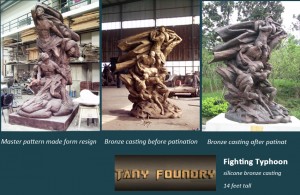| Sculpture Name | Fighting Typhoon |
| Artists | Xiang Long; Yunke Qian; Cheng Zhu; Qingzhu Meng |
| Material | Silicone Bronze |
| Measurement | 14 feet tall tall |
| Casting Method | Bronze casting as one piece |
Background: Typhoon occurring in between summer and spring every year is very common in south east China. It’s extremely destructive like hurricane attaching Florida, US. This statue is for memorizing people who participating in fighting against typhoon and rescuing civilians in the natural disaster. The tense atmosphere can be clearly seen from this sculpture and you can view this statue from any angle you want. This is another feature of this work.
As a leading bronze sculpture foundry in China, Tany Foundry has rich experience on casting monumental sculptures.
Production Process: it’s clear that this is a sculpture with complicated structure and details. It’s difficult to cast figures separately and assembly them later because there is no clear partition line between figures and partial casting could cause damage to the final visual effect. Therefore, we decide to cast this sculpture as a whole piece.
Here is the workflow:
Fiberglass pattern – Making silicone mould – Wax mould – Internal investment (refractory like plaster ) – Refining wax mould – External investment – Heating, Kiln burnout – Bronze pouring – Cleaning, sand blasting – Removing pouring system and casting trace – Finishing, refining – Polishing – Patination
The first step is to make a silicone mould from the fiberglass pattern. Duo to the size of the statue, we have to make separate silicone moulds according to its structure and add a plaster jacket outside of silicone. The purpose of the plaster jacket is to avoid silicone mould distortion. This is important because severe distortion may cause the wax mould parts can’t fit well with each other. After the silicone moulds are prepared, we create wax moulds by brushing hot liquid wax onto the silicone. Just like the silicone moulds, we create wax mould separately and assembly them together afterwards. Next, we work with artists closely to refine the finished wax work. One of the challenges is the work has to reflect the “muddy feeling” of those figure who were fighting against the typhoon very hard. To handle this issue, we come up with an idea: spraying a little bit of molten wax onto the wax figure. And, Bingo! Those figures now look muddy and tired. This small technique greatly captures the spirit of this sculpture.
After the wax mould is finished, now we do the investment job by applying refractory onto the waxwork. Duo to the size of this project, we spend total SEVEN days to burnout and firing. The pour is very successful and we got a beautiful look sculpture. The work of cleaning the refractory is worth of great attention because any carelessness would cause damage the sculpture finish. Then we cut the sprues (the pouring system) and refining sculpture’s finish. Previously, our engineer design those sprues at those unnoticeable places so this work doesn’t take long.
The hard part is patination, the artists spend quite a few time to figure out the “right tone” for this statue and we assist them do the patination with different solution. Finally, artists decide using reddish dark brown color and our patinar finish the job.
Hi guys, I’d like to hear your comments mu post and feel free to let me know if you have any question.


Thank you to the person who senakpd blankenstein. I hate those kinds of comments as well….so old…so ignorant and uneducated. It is obvious these people know nothing of the artist and perhaps little about modern art itself. People think that they can look at a work for 2 seconds – a work that may have in reality taken the artists years to conceive of – and make an immediate call on whether it is or is not art. In order to truly decide on something like that (if its even possible), I feel one must at least do 2 things:1. Know the artist’s history – this includes info about his previous works, style, and level of output, etc.2. Know the artist’s intent – what is he trying to convey to his audience. For what purpose does he create?The 6 yr old comparison does not hold water for me because although a six year old may physically be able to construct what Wentworth created, the intent and artistic history experience are lacking. That is why a six year old could NEVER have done what Wentworth did.
Сайт Винница грамм шишек бошек марихуаны Ресурс Ужгород сколько весит одна шишка бошка марихуаны